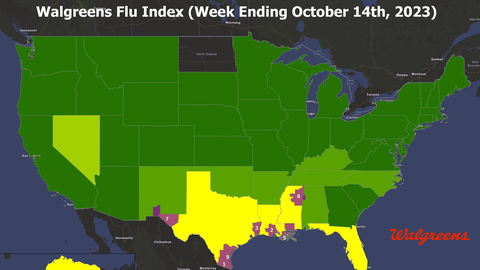Walgreens Flu Index Shows Flu Activity Steadily Climbing This Season
This more gradual start to flu season could foreshadow a return to pre-pandemic patterns of flu activity; Walgreens recommends getting vaccinated now.

Walgreens launched the 2023-2024 Walgreens Flu Index today to help communities track flu activity in their area and serve as an important reminder to take preventive measures, including an annual flu shot. (Graphic: Business Wire)
The Walgreens Flu Index shows that, to date, overall flu activity is
“After several atypical flu seasons, this year’s Flu Index is showing a more gradual ramp-up of flu activity closer to the pre-COVID norm,” said Kevin Ban, MD, Chief Medical Officer, Walgreens. “While it’s early days and flu season is always unpredictable, our historical data suggest this could be a return to a typical two-wave flu season where activity starts to peak in December and reaches its highest point in February, rather than the single peak we saw last year, which was earlier but lower than the norm.”
Despite the unusual patterns of flu activity last season, the virus still had a major impact on communities and the healthcare system, driving a similar level of illnesses, hospitalizations and deaths as in pre-pandemic years and contributing to the ‘tripledemic’ of flu, COVID-19 and RSV in the
The Centers for Disease Control and Prevention (CDC) recommends that everyone 6 months and older get a flu vaccine by the end of October.2 However, if individuals cannot get vaccinated until later, the CDC recommends still getting the flu shot because significant flu activity can continue through May.3 It takes about two weeks after receiving the vaccine for antibodies to develop in the body and provide protection against the flu.
“It’s just as important as ever to get your annual flu shot, and now is the time to do it,” said Dr. Ban. “With COVID-19 surging, pandemic precautions continuing to ease, and people gathering in person more frequently this fall and winter, keeping up with all CDC-recommended immunizations is the best way to keep you and your loved ones protected as we head into the holidays and peak flu season. As our pharmacy teams are working tirelessly to serve our communities, Walgreens makes it easy for the whole family to get annual flu shots, the updated COVID-19 vaccine and the RSV vaccine for those eligible, all in one visit.”
Flu and COVID-19 vaccines are available at no cost to patients with most insurance or government assistance. To schedule a vaccination appointment, visit Walgreens.com/ScheduleVaccine, use the Walgreens app or call 1-800-WALGREENS.
Walgreens also offers a variety of convenient, low-cost testing and treatment options to simplify the path to recovery for individuals experiencing respiratory symptoms, including a rapid 2 results in 1 test for COVID-19 and influenza A and B that are now available at most locations nationwide. To learn more, visit Walgreens.com/Testing, use the Walgreens app or call 1-800-WALGREENS.
Top 10 DMAs with Highest Flu Activity
1.
2.
3.
4.
5.
6.
7.
8.
9.
10.
Top 10 States and Territories with Highest Flu Activity
1.
2.
3.
4.
5.
6.
7.
8.
9.
10.
About the Walgreens Flu Index®
The Walgreens Flu Index® is an online, interactive tool that ranks the top markets and states for flu activity in
Every week, Walgreens tracks the incremental change of antiviral medications used to treat influenza across thousands of Walgreens and Duane Reade locations nationwide to create the Walgreens Flu Index®. Data for the Walgreens Flu Index® is analyzed at state and geographic market levels to measure absolute impact and incremental change of antiviral medications on a per store average basis and does not include markets in which Walgreens has fewer than 10 retail locations.
The index is not intended to illustrate flu severity, but rather, based on this methodology, to show which populations are experiencing the highest incidence of influenza within
About Walgreens
Walgreens (www.walgreens.com) is included in the
1 Centers for Disease Control and Prevention. “Vaccine Effectiveness: How Well Do Flu Vaccines Work?” February 28, 2023. https://www.cdc.gov/flu/vaccines-work/vaccineeffect.htm
2 Centers for Disease Control and Prevention. “Who Needs a Flu Vaccine.” August 25, 2023. https://www.cdc.gov/flu/prevent/vaccinations.htm
3 Centers for Disease Control and Prevention. “Flu Season.” September 20, 2022. https://www.cdc.gov/flu/about/season/index.html
View source version on businesswire.com: https://www.businesswire.com/news/home/20231019216442/en/
Stephanie Corcilius
Walgreens Media Relations
media@walgreens.com
Source: Walgreens







